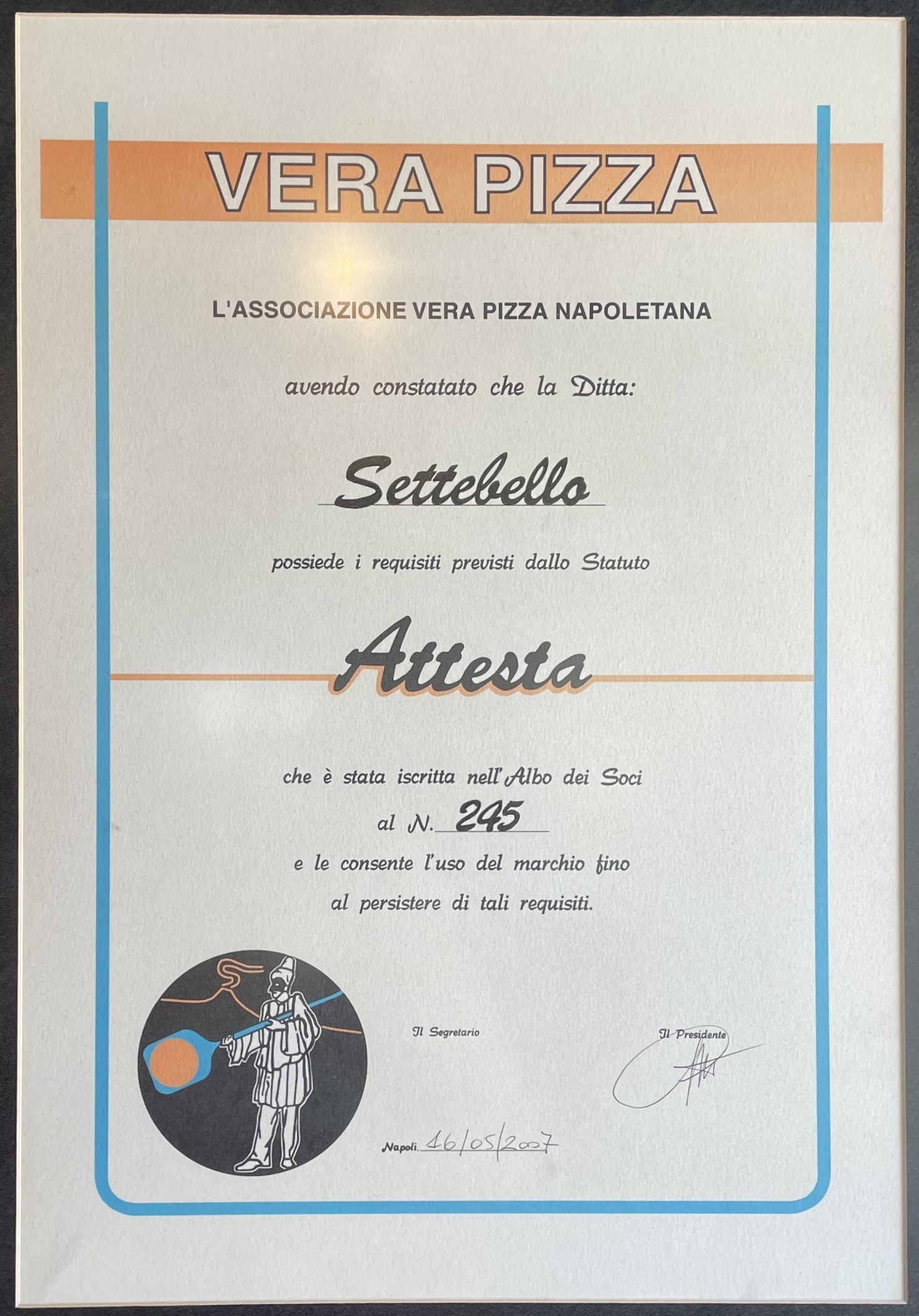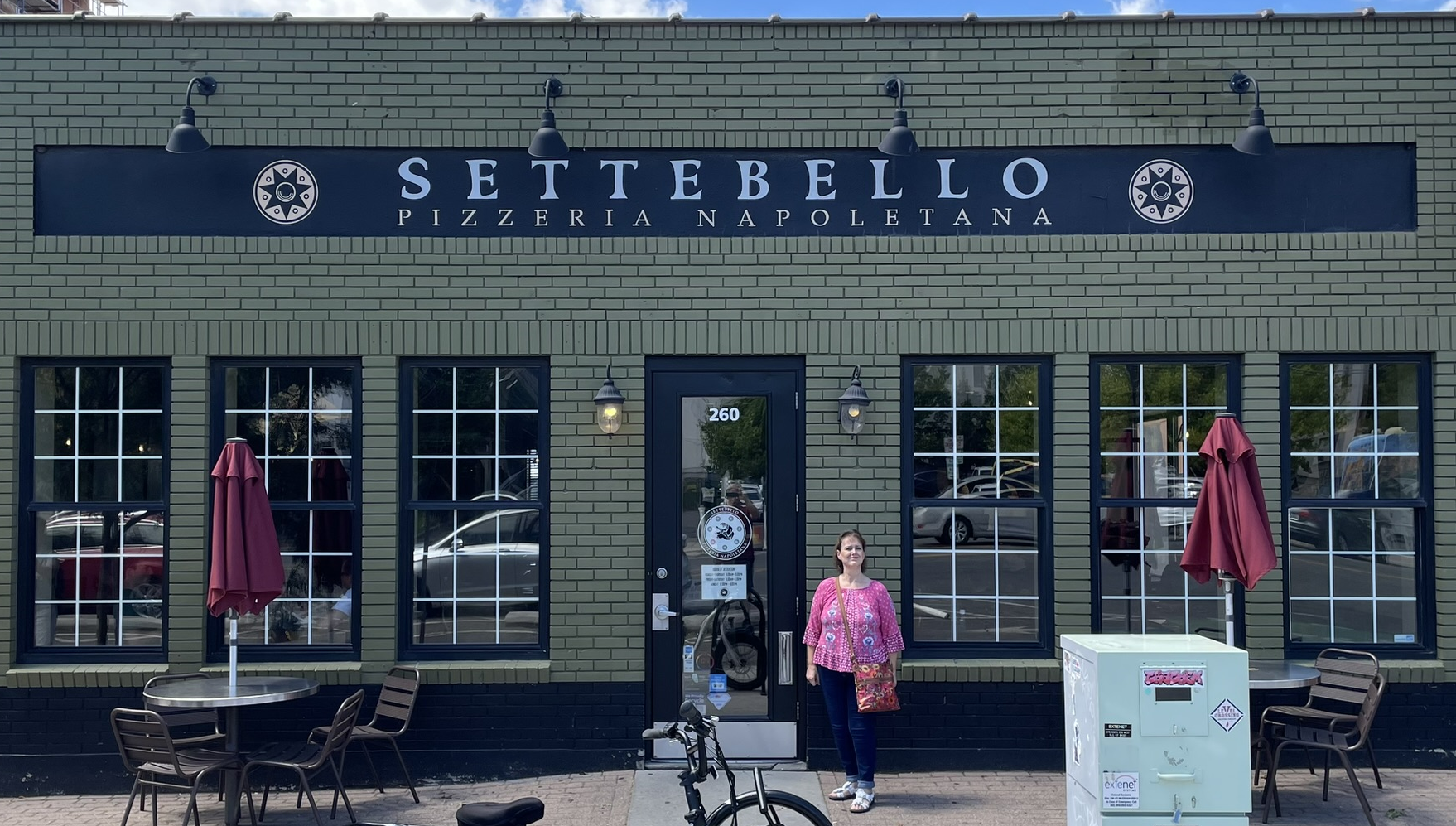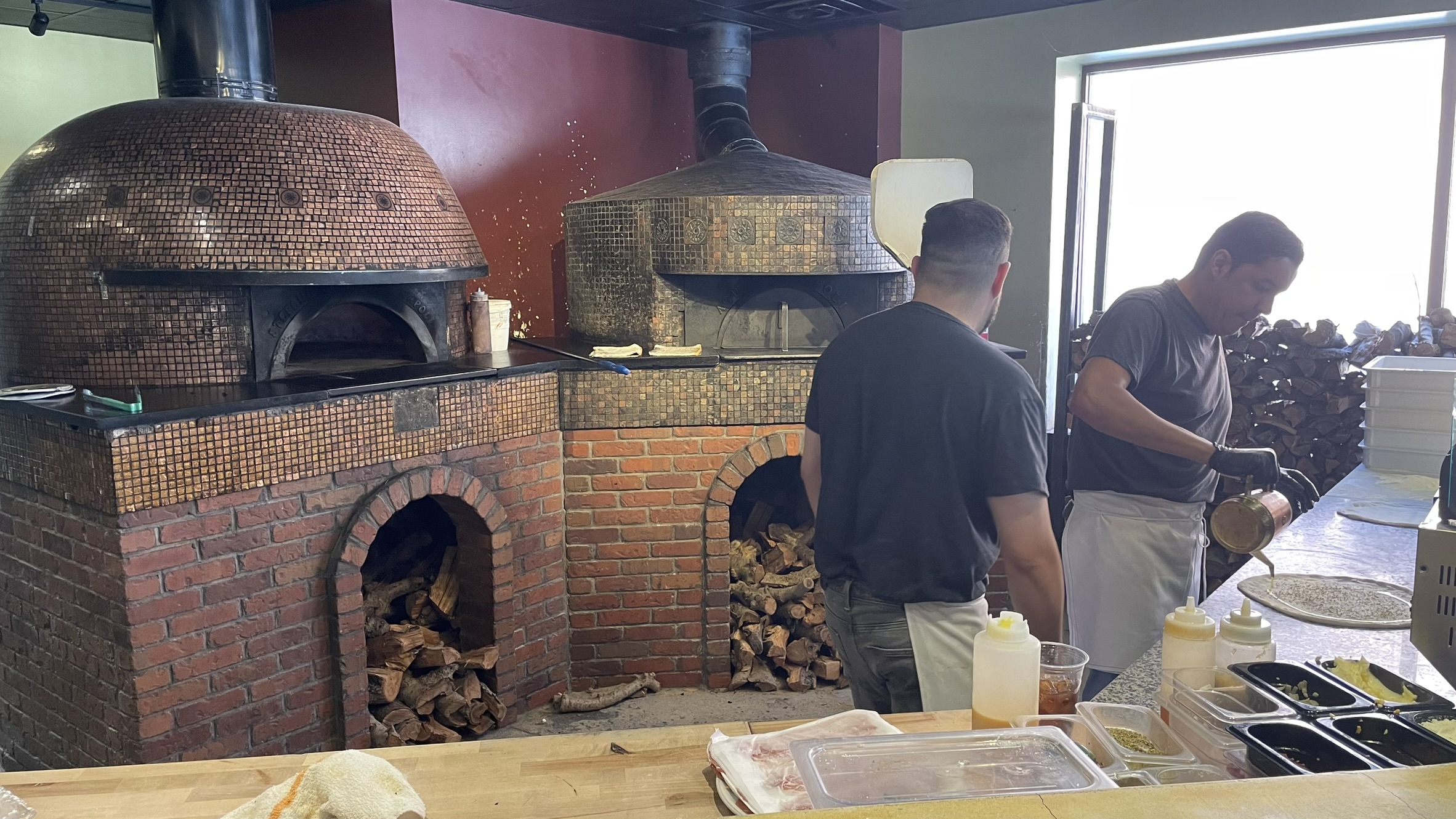
Settebello Pizzeria Napoletana
He said:
Kathy’s been pressing me for weeks to order pizza, so today I decided we should go out for some. There are, of course, many different local destinations for pizza. We could even narrow our choices by style: New York, with its thin, foldable crusts; deep dish Chicago (usually my favorite); Detroit, with cheese to the very edge of its thick, buttery crusts, to name a few. Today, we turned to a classic, the original pizza style, perhaps: Neapolitan.
Neapolitan pizza has a long history. Mastunicola, a precursor to modern pizza, came from Italy around the year 1600. A staple food for the Naples working class, mastunicola consisted of a soft and chewy crust with toppings, baked in a wood-fire oven. It didn’t quite resemble today’s pizzas, however, as it lacked tomatoes. Instead, it was topped with lard, fresh basil leaves, sharp, hard cheese, and black pepper. Later, extra virgin olive oil would replace the lard.
Tomatoes had already been introduced to Europe, having been brought from Peru by the early Spanish conquistadors. However, for a long time they were mistakenly believed to be poisonous, due to their association with the nightshade family. It wouldn’t be until the late 18th century that tomatoes began to be used to top pizzas. Raffaele Esposito, a Napoli baker, started to top pizzas with tomatoes, mozzarella, and basil leaves, creating the first “tomato and mozzarella” pizzas. In 1889, these were served to King Umberto I and Queen Margherita during an official visit to Naples. They loved the coloring of the pizza, which resembled the colors of the Italian flag . This style of pizza has been known as Margherita pizza ever since1 and has become the classic form of Neapolitan pizza.
More broadly, Neapolitan pizza is characterized by the simplicity of both its ingredients and preparation. Well, I say “simplicity,” but to do it right is actually quite complicated. To that end, the Associazione Verace Pizza Napoletana (AVPN) was formed to formalize the standards of Neapolitan pizza-making. They offer certifications to pizzerias around the world that adhere to strict guidelines and traditional methods of making Neapolitan pizza. This ensures authenticity and quality.

As Settebello Pizzeria holds a certification from AVPN, they use only high-quality ingredients, of which they have a surprisingly short list. You won’t find any pineapple at Settebello’s, for example. Dough is made and stretched by hand and pizzas are cooked in wood-burning ovens.
We began our meal with an antipasti plate of Misto. This consisted of a variety of Italian meats and cheeses. The menu said it included vegetables too, but ours didn’t include any. At least, I assume Salami still isn’t a vegetable. The Misto also came with Focaccia, which turned out to be a regular pizza crust, cooked plain and then topped with olive oil and herbs. They also brought bottles of Balsamic vinegar, olive oil, and spicy olive oil to our table.

At Settebello’s, the pizzas all come in one size, about the size of a plate. We could have easily split one, but instead we each ordered our own. Since Kathy ordered the namesake Settebello pizza, I decided to stick to basics. They had two versions of the Margherita. I chose the “DOC” version, which used Mozzarella di Bufala instead of plain Mozzarella. The “DOC” refers to the “Denominazione di Origine Controllata,” a classification that should ensure the authenticity of the cheese. In this case, the Mozzarella should be made not from cow’s milk, but from the milk of an Italian Mediterranean buffalo, a breed of water buffalo. Either way, the Margherita pizzas stick to the traditional crushed tomatoes, Mozzarella, Parmigiano, Basil, and Olive Oil.

My pizza had great color: red tomatoes, toasted Mozzarella, green basil leaves, golden crust. The sauce looked a little bit soupy, to be honest, especially in the center. I let it sit a moment before I cut into it, hoping it would firm up a bit.
Part of the charm of Neapolitan pizzas is the way they make the crusts. The dough is hand-pressed, fingertips pushing the embedded air bubbles away from the center as the dough is stretched. This creates a thin crust in the center of the pizza, with an edge that rises to a soft, chewy rim known as the cornicione. The cornicione is thicker and puffier than the rest of the crust, making it a hallmark feature of Neapolitan pizzas.
In this case, I loved the cornicione and its chewy, robust breadiness. However, I was not a fan of the soft, floppy center, made soggy by the tomato juice. I couldn’t pick up the pieces until I had eaten the center with a fork and knife. It’s really the only complaint I had, but it’s kind of a doozy for me. On the other hand, the Mozzarella di Bufala was wonderfully sweet and decadent. In true Neapolitan fashion, the Mozzarella was torn into pieces and spread haphazardly over the pie’s surface.
She said:
When Brian told me he wanted to review a pizza place, I was practically salivating. I’ve been a diehard pizza fan since I was a little girl. It all started with those Chef Boyardee/Kraft pizza kits that my mom used to buy. Sure, they were cheap, mediocre pizzas, but I couldn’t wait to shove the slices into my drooling mouth. As an adult, my tastes became much more discerning. 😏
Now, about Settebello’s. At first glance, the exterior had great curb appeal. Pale olive-green brick. Black and white signage. Black-trimmed paned windows. A large, vibrantly colored mural in reds, browns, white, black, and gray that depicted a diabolical kind of character wielding a pizza peel. There was also an adjoining gelato shop.

Upon entering, we were immediately greeted by a hostess who took us to a table and handed us a couple of menus. Not long afterwards, a waiter approached us with glasses of iced water and an explanation of the restaurant and menu items. He pointed out that they were exclusively a pizza joint that offered salads and appetizers. They do not offer pasta at all.
I chose the house favorite, the Settebello, because it included sausage, pancetta, and mushrooms. While waiting for our orders to come up, I took in our surroundings. A few walls were painted maroon, while others were yellow. Black and white canvas photos adorned a far wall. The ledge created by a pony wall had copper cruses of varying styles and sizes set on top of it. The floors were fashioned of charcoal gray concrete with cracks in it. I couldn’t tell if the cracks were natural or a stylistic design choice. On the opposite wall from us, there were two large brick and tile ovens and a bay of fresh ingredients in easy reach of the chefs. The restaurant had a relaxed vibe and atmosphere.

Before I talk about our meal, I want to mention that after Brian had told me about the AVPN rating and stringent rules/regulations, I was expecting to be served exceptional pizza. Unfortunately, my expectations were dashed. Granted, all of the ingredients were fresh and of the highest quality. However, they did nothing to improve the overall finalized product.
First of all, the pizza crust was burned in places and soggy in others. The sogginess probably came from the failure to completely drain the juices from the crushed tomatoes. There was no mess-free way to eat it except by using a knife and fork.
Also, I would have preferred having the ingredients spread out more evenly over the dough. Not only that, though. I would have liked much more of the cheese, mushrooms, pancetta, and sausage because they were delicious. In fact, they were the only ingredients that leant some flavor to my pie. The crushed tomatoes may have come from San Marzano, but they were plain and devoid of any seasonings.

The one thing we ordered that I deemed top notch was the meat and cheese platter. The salami, bologna, prosciutto, and other meats were delicious, tender, and obviously of high quality. The white cheeses we were served were appropriately sharp and hard. Feasting on these foods was my favorite part of the meal. (Oh, and I’m with Brian on this one: Where were the vegetables?)
So, while I enjoyed going out for lunch, the pizza fell short of my personal expectations for flavor, texture, and the variety and quantity of toppings.
Conclusion:
If you’re looking for authentic, certified Neapolitan pizzas made with high quality ingredients, give Settebello Pizzeria Napoletana a try.
-
This traditional origin story of the Margherita pizza may be apocryphal, but so are many legends.↩